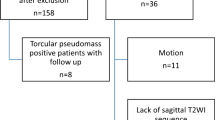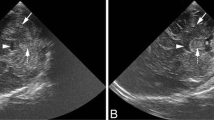Abstract
Objective. Hyperdense posterior falx and/or torcula on unenhanced CT scans is associated with sagittal sinus thrombosis in adults. However, the validity of this finding in newborns is unknown. Materials and methods. A prospective review was performed from September 1995 to November 1996, evaluating head CT scans of infants during their first week of life. Results. Eleven neonatal head CT scans revealed a hyperdense posterior falx, suggestive of sagittal sinus thrombosis. Further imaging (7 ultrasound and 4 magnetic resonance imaging examinations) revealed no evidence of venous thrombosis in 10 of the 11 infants. Conclusion. Predominantly unmyelinated neonatal brain and increased hematocrit of neonatal blood probably contribute to the false impression of hyperdense posterior falx/torcula on neonatal head CT scans.
Similar content being viewed by others
Author information
Authors and Affiliations
Additional information
Received: 30 December 1997 Accepted: 9 April 1998
Rights and permissions
About this article
Cite this article
Kriss, V. Hyperdense posterior falx in the neonate. Pediatric Radiology 28, 817–819 (1998). https://doi.org/10.1007/s002470050472
Issue Date:
DOI: https://doi.org/10.1007/s002470050472




